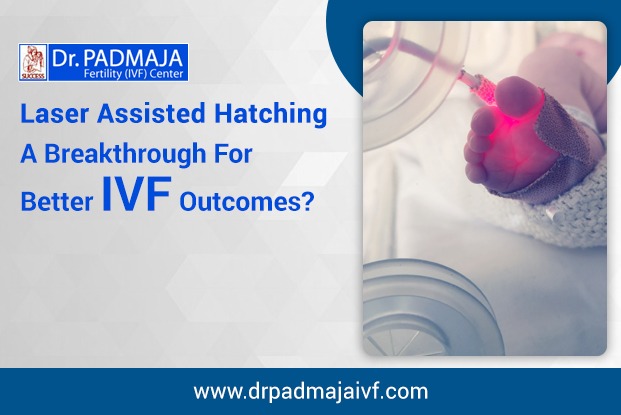For couples struggling with infertility, every small advancement in fertility science brings new hope. One such breakthrough in assisted reproductive technology (ART) is Laser Assisted Hatching (LAH). This technique has been gaining popularity for its ability to improve the success rates of IVF by helping embryos implant more effectively in the uterus.
At the Dr Padmaja IVF Center, one of the best fertility centres in Hyderabad, laser assisted hatching is performed with precision and care, offering renewed hope to many couples who have had difficulty conceiving. In this blog, we’ll explore what laser assisted hatching is, how it works, who it benefits, and why more fertility specialists are recommending it for improved IVF outcomes.
What is Laser Assisted Hatching?
Laser Assisted Hatching is a laboratory technique used during IVF (in vitro fertilization) procedures. It entails utilizing a safe, concentrated laser beam to create a tiny hole in the zona pellucida, an embryo’s outer shell. This helps the embryo hatch and implant more easily into the uterus lining, increasing the chances of a successful pregnancy.
This procedure is done just before the embryo is transferred to the uterus. At fertility treatment centers in Hyderabad, including the DrPadmaja Fertility Center, laser assisted hatching is offered as an additional step in IVF treatment, especially for patients who have experienced repeated IVF failures or are using frozen embryos.
Why is Hatching Important in IVF?
In a natural pregnancy, once an embryo reaches the blastocyst stage (typically around day 5–6), it naturally breaks through the zona pellucida to implant itself into the uterine lining. However, in some cases, this process does not happen as effectively, especially in lab-cultured embryos.
Embryos that are frozen and thawed, or those from older women, may have a harder outer shell that makes it difficult to hatch. This is where laser assisted hatching helps. It improves the embryo’s chances of adhering to the uterus by gradually opening or thinned the shell.
Who Can Benefit From Laser Assisted Hatching?
Laser aided hatching is not necessary for every IVF patient, although it can be especially helpful for:
Women above 35 years of age
Couples with previous failed IVF cycles
Patients using frozen-thawed embryos
Couples with unexplained infertility
Cases with embryos showing thick zona pellucida
Low embryo implantation rates
At Dr Padmaja IVF Center, one of the most trusted IVF treatment centers in Hyderabad, infertility doctors assess each case individually and suggest laser assisted hatching if it could improve the chances of success.
How is Laser Assisted Hatching Performed?
Using high-precision equipment, laser aided hatching is a rapid and secure operation carried out in the IVF lab. Here’s how it works:
Embryo Preparation: On the day of embryo transfer, the embryologist selects healthy embryos for hatching.
Laser Application: A micromanipulator is used to focus a laser beam on the outer shell of the embryo, creating a tiny opening or thinning a section of the shell.
Transfer to Uterus: After the procedure, the embryo is carefully placed into the woman’s uterus for implantation.
The entire process is non-invasive to the embryo and done under sterile and controlled lab conditions. Clinics like the DrPadmaja Fertility Center, known as one of the best IVF centers in Hyderabad, use cutting-edge laser systems for maximum safety and precision.
What Are the Benefits of Laser Assisted Hatching?
Improved Implantation Rates: Helps embryos attach to the uterus more effectively.
Better Outcomes for Frozen Embryos: Assists thawed embryos with tougher shells to implant.
Higher Success for Older Women: Age-related fertility decline is addressed by supporting embryo hatching.
Boosts IVF Success: Especially useful for couples with multiple failed IVF attempts.
With the expertise of DrPadmaja infertility doctors, patients receive personalized fertility care, including whether LAH would benefit their specific situation.
IVF Cost and Laser Assisted Hatching
When considering fertility treatment, cost is always a concern. While laser assisted hatching is an additional step in the IVF process, it is relatively affordable and cost-effective when weighed against the potential improvement in success rates.
At Dr Padmaja IVF Center, patients are provided transparent and competitive pricing. The IVF cost may vary depending on individual needs and whether advanced techniques like LAH are recommended. However, the ultimate goal is always to increase your chances of conceiving while keeping treatment accessible.
Why Choose Dr Padmaja IVF Center?
When it comes to fertility care, choosing the right center can make all the difference. Here’s why patients trust Dr Padmaja IVF Center—one of the best fertility centres in Hyderabad:
Experienced Infertility Doctors in Hyderabad: The team is led by renowned fertility specialists who offer expert guidance and compassionate care.
Advanced Laboratory Techniques: Including laser assisted hatching, embryo freezing, ICSI, and more.
Customized Fertility Solutions: Every patient receives a personalized plan tailored to their fertility journey.
High Success Rates: Backed by science, technology, and a team that truly cares.
Final Thoughts
Laser Assisted Hatching represents a significant step forward in assisted reproductive technology, especially for those who have faced challenges with IVF in the past. This innovative procedure gives embryos a better chance of implanting, which means more hopeful parents may finally experience the joy of pregnancy.
If you’re considering IVF treatment in Hyderabad, speak with the experienced team at the DrPadmaja Fertility Center. With a caring approach and advanced technologies like LAH, their expert team of infertility doctors in Hyderabad is here to help you every step of the way.
Let science work for your dream of parenthood—because every embryo deserves the best chance to grow.
About the Author

This blog is penned by a devoted content specialist passionate about raising awareness around fertility treatments and emotional well- being. With in- depth disquisition on motifs like IVF and fertility, the thing is to give precious perceptivity for couples on their trip to parenthood.
Frequently Asked Questions (FAQs)
- What is Laser Assisted Hatching (LAH)?
Laser Assisted Hatching is an advanced laboratory technique used during IVF. It involves creating a small opening in the outer shell (zona pellucida) of the embryo using a laser to help the embryo hatch and implant into the uterus more easily.
- Why is hatching important in IVF?
For successful implantation, the embryo must “hatch” from its outer shell and attach to the uterine lining. In some cases, this process doesn’t occur naturally, and assisted hatching improves the chances of successful implantation.
- Is Laser Assisted Hatching safe for the embryo?
Yes. LAH is a precise and controlled technique. The laser is applied only to the outer shell and does not damage the embryo itself when performed by experienced embryologists.
- Does LAH improve IVF success rates?
In selected cases, especially for women with previous IVF failures or poor embryo implantation, LAH can improve success rates by aiding embryo implantation into the uterus.
- How is the procedure performed?
LAH is done in the IVF lab before embryo transfer. A laser is used under a microscope to gently thin or create a small hole in the embryo’s outer shell.
- Is LAH recommended for all IVF patients?
Not always. Your fertility specialist will evaluate your age, embryo quality, and previous IVF outcomes before recommending LAH. It is typically used in specific cases rather than routine IVF.
- Does LAH increase the risk of multiple pregnancies?
No. LAH is unrelated to the number of embryos transferred. The risk of multiples depends on how many embryos are placed in the uterus, not the hatching technique.

